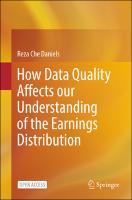How Data Quality Affects our Understanding of the Earnings Distribution
| dc.contributor.author | Daniels, Reza Che | |
| dc.date.accessioned | 2023-02-13T17:28:20Z | |
| dc.date.available | 2023-02-13T17:28:20Z | |
| dc.date.issued | 2022 | |
| dc.identifier | ONIX_20230213_9789811936395_60 | |
| dc.identifier | OCN: 1336589330 | |
| dc.identifier.uri | https://library.oapen.org/handle/20.500.12657/61325 | |
| dc.description.abstract | This open access book demonstrates how data quality issues affect all surveys and proposes methods that can be utilised to deal with the observable components of survey error in a statistically sound manner. This book begins by profiling the post-Apartheid period in South Africa's history when the sampling frame and survey methodology for household surveys was undergoing periodic changes due to the changing geopolitical landscape in the country. This book profiles how different components of error had disproportionate magnitudes in different survey years, including coverage error, sampling error, nonresponse error, measurement error, processing error and adjustment error. The parameters of interest concern the earnings distribution, but despite this outcome of interest, the discussion is generalizable to any question in a random sample survey of households or firms. This book then investigates questionnaire design and item nonresponse by building a response propensity model for the employee income question in two South African labour market surveys: the October Household Survey (OHS, 1997-1999) and the Labour Force Survey (LFS, 2000-2003). This time period isolates a period of changing questionnaire design for the income question. Finally, this book is concerned with how to employee income data with a mixture of continuous data, bounded response data and nonresponse. A variable with this mixture of data types is called coarse data. Because the income question consists of two parts -- an initial, exact income question and a bounded income follow-up question -- the resulting statistical distribution of employee income is both continuous and discrete. The book shows researchers how to appropriately deal with coarse income data using multiple imputation. The take-home message from this book is that researchers have a responsibility to treat data quality concerns in a statistically sound manner, rather than making adjustments to public-use data in arbitrary ways, often underpinned by undefensible assumptions about an implicit unobservable loss function in the data. The demonstration of how this can be done provides a replicable concept map with applicable methods that can be utilised in any sample survey. | |
| dc.language | English | |
| dc.subject.classification | thema EDItEUR::P Mathematics and Science::PB Mathematics::PBT Probability and statistics | en_US |
| dc.subject.classification | thema EDItEUR::K Economics, Finance, Business and Management::KC Economics | en_US |
| dc.subject.classification | thema EDItEUR::N History and Archaeology::NH History::NHH African history | en_US |
| dc.subject.other | Methodology for Collecting | |
| dc.subject.other | Estimating and Organizing Microeconomic Data | |
| dc.subject.other | Survey Methods | |
| dc.subject.other | Total Survey Error | |
| dc.subject.other | Response Propensity Models | |
| dc.subject.other | Multiple Imputation | |
| dc.subject.other | Income Distribution | |
| dc.title | How Data Quality Affects our Understanding of the Earnings Distribution | |
| dc.type | book | |
| oapen.identifier.doi | 10.1007/978-981-19-3639-5 | |
| oapen.relation.isPublishedBy | 6c6992af-b843-4f46-859c-f6e9998e40d5 | |
| oapen.relation.isFundedBy | 94ca1040-a907-4251-98bd-2d9a1734557f | |
| oapen.relation.isbn | 9789811936395 | |
| oapen.imprint | Springer Nature Singapore | |
| oapen.pages | 114 | |
| oapen.place.publication | Singapore | |
| oapen.grant.number | [...] |

